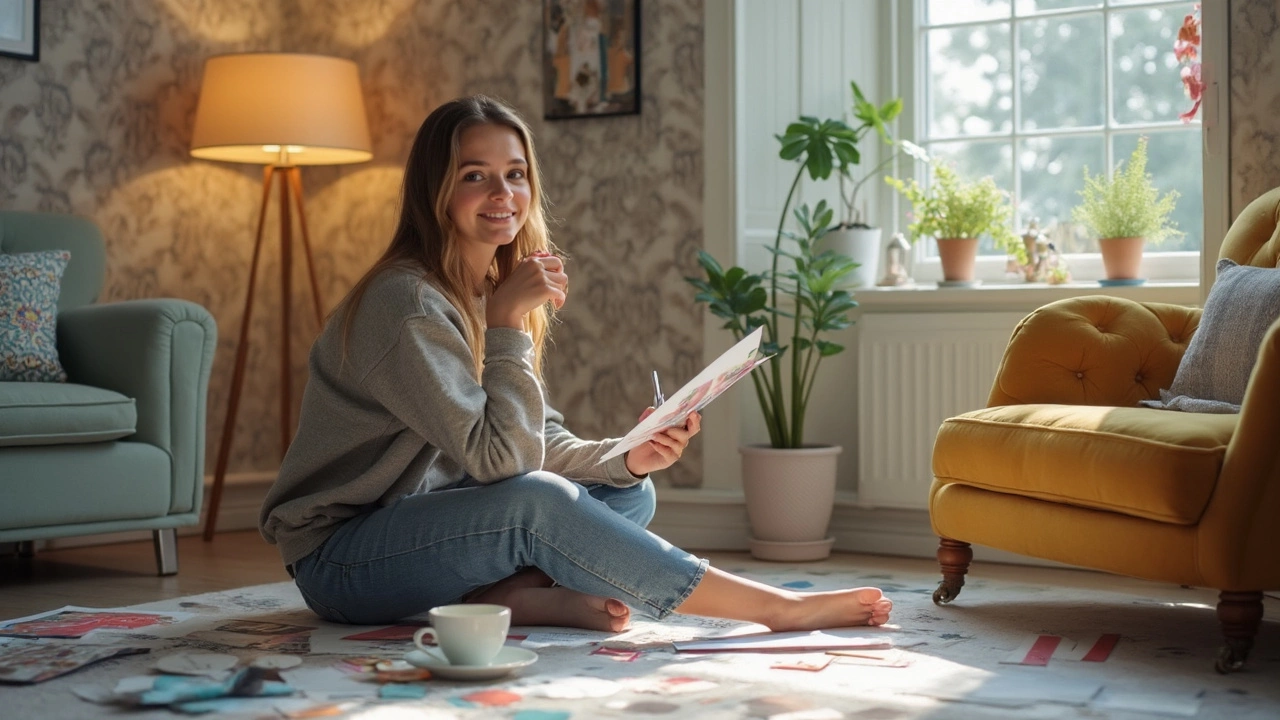Most people think you need an art degree or tons of money to get into interior decorating—but that's just not true. What you really need? A sharp eye for style, some guts to get started, and a plan that makes sense for real life. Interior decorating is wide open for anyone willing to put their creativity to work and hustle a little.
Your first step is seeing if you truly love this stuff. Do you find yourself constantly rearranging furniture, helping friends pick paint colors, or binge-watching room makeovers? That kind of passion goes way further in this field than any fancy diploma. But let's be real: It's not just playing with pillows. Working with budgets, dealing with tricky spaces, and listening to what clients actually want are all part of the gig.
If that sounds good, keep reading. There are smart ways to pick up skills, build a killer portfolio even if you’ve never been paid for a job, and actually get people to trust you with their rooms (and their money). You don’t need perfection—just a plan and the right push to get started.
- Figuring Out If Decorating Is Right for You
- Learning the Essentials Without a Fancy Degree
- Building Your Portfolio from Scratch
- Finding Clients and Getting Paid Work
Figuring Out If Decorating Is Right for You
Let’s get straight to the point. Before rushing into a new gig, you’ve got to be sure interior decorating fits how you want to work and live. This isn’t just about fluffing pillows or scrolling Pinterest. It’s hands-on, sometimes messy, and you’ll be dealing with all sorts of personalities and budgets. Are you the kind of person who sees a blank room and instantly pictures what it could become? That’s a huge plus.
Here are some signs decorating might be your thing:
- You’re always tweaking your own space or helping friends with theirs, just for fun.
- You love shopping for home stuff more than clothes or tech gadgets.
- You catch details nobody else does (like how lamp light changes a room’s vibe).
- You don’t melt down when plans change or when someone says they hate your color pick—flexibility is your superpower.
- You’re curious about different styles, trends, and pieces from all price ranges (not just high-end).
But let’s talk real life: Interior decorators spend a lot of time solving practical problems, not just picking pretty things. Clients might have tiny budgets, outdated spaces, or totally different tastes. Communication is key. You’ll have to explain your ideas in a way that gets people excited and makes sense to them.
Don’t just take my word for it—look at what the numbers say. The table below shows a snapshot of what new decorators in the US face, based on a 2024 survey of entry-level designers and decorators:
| Fact | Detail |
|---|---|
| Average starting pay | $19/hour |
| Biggest stressor | Managing client expectations (62%) |
| Hours per week | Flexible, but usually 20–35 |
| Most common career backgrounds | Retail, customer service, DIY, event planning |
If this all clicks and you still feel hyped, you’re already on the right track. The next step? Learning the basics without shelling out loads of cash for a fancy degree.
Learning the Essentials Without a Fancy Degree
You don’t have to drop thousands on a design degree to start in interior decorating. In fact, loads of working decorators either taught themselves or took short practical courses online. The basics come down to understanding space, color, and how to make things both look good and work for real life. That foundation is more important than memorizing fancy design history or name-dropping expensive furniture brands.
One of the easiest ways to get started is with free or cheap online resources. Sites like YouTube have hours of step-by-step room makeovers, space planning ideas, and decorating hacks. Look up credible channels like The DIY Mommy, Apartment Therapy, or Emily Henderson—real working designers who share what actually works, not just what looks good in a magazine. Some community colleges and adult education centers also offer low-cost classes if you want something a bit more structured.
- Pick up books like “Styled” by Emily Henderson or “Domino: The Book of Decorating” for quick tips you can actually use at home.
- Play with free floor-planning tools online. Try Floorplanner or Roomstyler to visualize layout ideas without spending a dime on real furniture.
- Practice by reworking rooms in your own place or helping friends out. Snap before-and-after photos—these will help you spot what makes a space pop.
Don’t forget, you’ll need to learn the not-so-glam parts of the job: measuring spaces, balancing budgets, and sticking to safety rules. It’s smart to read up on basic home improvement ideas, paint finishes, lighting types, and the difference between interior decorating and interior design. Keep a notebook or use your phone to jot down color combos, cool details you spot, or ideas you see in everyday life—creativity comes from everywhere, not just design school.
If you ever get stuck or just want feedback, pop into online groups for beginner decorators. Facebook groups or subreddits like r/InteriorDesign always have people willing to give advice, share resources, or suggest tools. The more you learn by actually doing, the faster you’ll build up the confidence to take on real projects.

Building Your Portfolio from Scratch
This is where a lot of newbies get stuck—how do you show off your design chops when you haven't had a paying gig yet? The answer: start close to home. Use your own space, a friend's living room, or even a boring corner in your apartment. Take before and after photos. Trust me, these photos matter way more than a fancy resume when you want to get noticed in interior decorating.
First, grab your phone (no need for a pro camera) and get decent daylight photos—people want to see the transformation clearly. Instead of shooting just from one spot, take several angles so you have options later. If you don’t have a space to work on, volunteer for family or friends with dated rooms. Most people are thrilled for free help, and you get projects to show off. Win-win.
- Pick three rooms or spots you can update (even if it’s just changing art or rearranging furniture).
- Document every step: your plan, mood boards, products you pick, the process, and final shots.
- Ask for written or video testimonials from the people you help—these add credibility fast.
Don’t ignore digital tools. Canva is a great free option for making mood boards, and Pinterest can help organize your ideas. Use Google Drive or Dropbox to keep all your project pics in one place so you don’t lose anything.
Once you have a few projects under your belt, put them into a simple online portfolio. This doesn’t need to be a fancy website—it can even be a well-organized Instagram page or a digital PDF. Recruiting site Houzz says 83% of people looking to hire a decorator use online portfolios to check work before even reaching out. If you don’t show your style and process online, you’re invisible to most clients.
| Portfolio Platform | Cost (per month) | Good For |
|---|---|---|
| $0 | Fast, visual updates | |
| Wix | $13 | Simple, templated website |
| Houzz | $0-$65 | Finding clients directly |
Keep adding every new project. Even small jobs count if the photos pop. Update your main page or PDF with your best work so your style comes through at a glance. Nobody expects a rookie to have ten years of experience—just proof you know how to make a room feel right.
Finding Clients and Getting Paid Work
This is the part where most new decorators get stuck. You’ve got your portfolio ready and your ideas are solid, but none of that matters if nobody knows you exist. Interior decorating is all about trust—people aren’t just hiring you to put up curtains, they’re letting you mess with their personal space. So, you’ve got to make yourself visible and legit, even while you’re just starting out.
Don’t bother waiting for your dream client to magically find you. Start by tapping your own network. Post your finished projects (even if they’re just makeovers of your own room) on Instagram, Facebook, or even TikTok. Tag the right spots—local furniture stores, paint brands, and real estate agents—so they see your work too. Many beginner decorators land their first gig from a friend-of-a-friend who saw a bedroom flip on social media. Word spreads fast if your transformations are impressive and your attitude is professional. In fact, 60% of small creative businesses say their first paying jobs came from personal connections, not ads.
It also pays to get out in the real world. Drop your business card or a flyer at neighborhood coffee shops, home improvement stores, or community boards. Volunteer to do a small redesign for a local shop or charity, just to get your name out and score some before-and-after photos. Those real-world projects feel safer to clients than a digital portfolio alone.
When someone shows interest, move fast—but don’t undersell yourself just to land the job. Set clear rates (hourly, flat fee, or package deals), and always outline what’s included so there’s no confusion later. Many new decorators start around $50 per hour, climbing higher once you’ve built a reputation. Put everything in writing: a simple contract, payment schedule, and even a list of what happens if the client changes their mind halfway. This protects both sides and marks you as a pro.
- Show off your interior decorating skills by sharing real before-and-afters, even from small projects.
- Network with local realtors, contractors, and stagers. They’re always looking for reliable decorators and can throw steady work your way.
- Sign up for local fairs or home shows. These are gold mines for meeting folks who have money to spend on their homes but want to meet someone in person first.
- Use sites like Houzz or Thumbtack to create an online listing. These sites let you collect client reviews, and many people look for decorators there before Googling local businesses.
Every paying job, no matter how tiny, is a stepping stone. If you rock a simple apartment refresh, that client could turn into a long-term customer or send three new people your way. Word-of-mouth is your best marketing tool, so make sure every client walks away thrilled (and remind them to leave you an online review). It’s all about showing up, doing your best work, and not giving up when the first few jobs are slow to come by.


